The Story of SPP.co

👋 Hiya, that's me – Chris. I started Service Provider Pro back in 2014 as a way to help automate a video production agency I was running at the time.
It was a productized service but nobody knew the term back then.
Clients picked one of our video styles, paid upfront, provided their project details in a form, and my team completed production from there.
We used a CRM for tracking leads, a shopping cart for checkout, there was a separate form builder tool for collecting project data, a help desk (and also direct email) for client messaging, a project management tool for internal updates, a spreadsheet for tracking delivered orders and on and on.
It was a mess. So I decided to build a better solution.
For a while SPP was just a tool for myself, and a few friends who needed a similar workflow for their own agencies, and were willing to cover some of the development time I had invested.

In the early days you actually had to download a zip file and install the software yourself (it was fine in the beginning but supporting webhost related issues got out of hand faaast).
We went on to build a new and improved SaaS version of SPP, and that's when things really started picking up.
Fast forward to today, SPP is used and loved by top names in SEO, content marketing and all types of digital marketing agencies you can think of.

We help sell millions of dollars in services each week, all with just a handful of people on staff. And we're not putting in 80-hour weeks either. I'm a huge fan of Basecamp's books and really strive to instill those ideas in our own company.
After all, if you're in the agency business, you know now how important sustainability is.
We're the same way... unlike many of the software startups which come and go these days.
They get you with a free, or a downright cheap subscription… only to hike up their prices, or get shut down altogether when funding runs out.
Not a business I wanna be in.
Given all that, I'm pleased to say we never took outside investment, and were profitable pretty much from day one. All thanks to our friends and supporters, some of who were crazy enough to pitch in for a solution that didn't exist yet (shoutout to our OG users, you know who you are!).

This has given us tremendous flexibility to build the product in a way that makes sense for our perfect customers – the people we actually enjoy working with.
The fact that you're here on this page, is probably because one of our happy users told you about SPP, and not because we spent an enormous amount of capital getting you to click an ad.
So if you sign up for one of our plans you can be sure your hard earned money goes towards building and improving the software your business relies on.
Give SPP a try, I'm absolutely convinced you'll love it. Also, feel free to reach out and we'll be thrilled to help.
I'll see you on the other side…

You're in good company. We've helped agencies like yours sell $500M+ in services.


